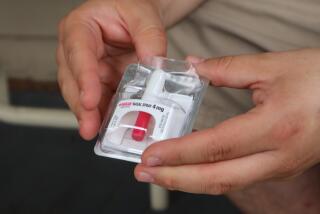Antidote Pills Will Go to Reactors’ Neighbors
- Share via
The state plans to distribute potassium iodide tablets to nearly half a million people living within 10 miles of nuclear generating stations in San Onofre and Diablo Canyon, saying the pills could help protect the public in the event of radiation exposure.
The decision comes six months after the Nuclear Regulatory Commission offered the pills to the 34 states with nuclear power reactors. Officials said the idea was developed over several years but took on urgency after the Sept. 11 terrorist attacks, which highlighted the vulnerability of the nation’s 103 nuclear power stations.
Pills will be given to 421,000 residents in the portions of San Diego and Orange counties that surround San Onofre and 22,000 residents in San Luis Obispo County, where Diablo Canyon is.
Millions who live near nuclear reactors in Connecticut, New Jersey, New York and eight other states received the pills this year, and officials in Ohio and Pennsylvania have requested them.
Though potassium iodide doesn’t shield against all types of radiation poisoning, it can protect the thyroid from absorbing radioactive iodine if taken in the first four hours of exposure. Thyroid cancer can result from radiation exposure.
Nuclear plants are considered possible terrorist targets because radioactive contamination could spread over wide areas. Federal officials said Monday that they know of no specific threats against any nuclear plants, which have been ordered to complete security upgrades by the end of August.
Officials at Southern California Edison, which owns San Onofre’s two working 1,120-megawatt reactors, insist that the plant is adequately protected.
The latest study to examine what might happen if a major radiation leak occurred was completed in 1982 and painted a grim picture.
If the dome on one of the two working reactors were breached, the study said, it could result in 27,000 deaths within a year of the accident, 18,000 additional long-term deaths from cancer and $186 billion in property damage. The study didn’t specifically theorize a terrorist attack.
Not So Simple
Government officials warned that distribution of potassium iodide tablets on such a large scale and involving such a sensitive public health issue can be fraught with confusion.
Nuclear Regulatory Commission spokesman Breck Henderson said some residents might erroneously believe that taking the pills would protect against all types of radiation when they protect the thyroid against only one type of radioactive isotope.
“The best protection is evacuation or [finding] shelter,” he said.
Other questions: How often to distribute the pills--they have a shelf life of only a few years--and how to deal with people moving from the area and taking the pills with them, leaving new occupants without? Nuclear plants such as San Onofre also have periodic drills using their emergency sirens, so residents would have to better warned so they don’t take the pills unnecessarily, Henderson said.
“This is one of those things where the devil is in the details,” added Dr. Mark Horton, Orange County’s health officer. “It isn’t so much that it’s not a good idea. It is a good idea, but how do you get them to the right people? How do you do it in an efficient, cost-effective way? I’m sure we’ll come up with a reasonable plan.”
In San Clemente, the city closest to San Onofre, a group called the Coalition for Responsible Ethical and Environmental Decisions has been crusading for the storage of potassium iodide pills as part of a broader platform for increased security since Sept. 11. But in Dana Point, there has been little clamor for the tablets, and officials there question whether the state’s plans make sense.
Sheryl Lindsey, Dana Point’s interim administrative services director, said the pills might be better administered by physicians because they are prescription-strength and could pose health risks to some users. (The NRC said a small percentage of people are allergic to the pills.)
“When you’re talking about administering prescription medication to a populace at large, I think that’s a more complex discussion than just ‘Let’s hand it out to everybody,’ ” Lindsey said. “It needs to be handled carefully, and we only hope the state will do that.”
Boundary Disputed
In San Luis Obispo, many residents say it’s unfair to only offer pills to those living in a 10-mile radius of the Diablo Canyon plant. The boundaries include all 18,000 residents Los Osos but leaves out the 10,000 residents of Morro Bay.
“You can’t draw a line and say people on one side of the street get it and people on the other side of the street do not,” said Shirley Bianchi, the county supervisor who represents the communities north of the plant.
San Luis Obispo County proposes that the pills be given to 143,000 permanent residents, as well as 85,000 coastal visitors on peak summer weekends.
Under the state’s plan, people living outside the 10-mile radius could order tablets at pharmacies or through the Internet. Each pill would cost $1 to $2.
Prodding the state into distributing the pills became a recent crusade for Orange County talk-show host Dana Roth of KPLS-AM (830). Three weeks ago, Roth began calling state officials on the air and asking why the pills hadn’t been given out.
“It took them seven months,” Roth said Monday. “That’s typical political bunk. California should be a leader; we shouldn’t be playing catch-up.”
The state’s plan took several months to complete because officials had hoped to first create a consistent policy with local officials on how and when to distribute the pills and where they would be stored, said Eric Lamoureux, spokesman for the state Office of Emergency Services.
“We weren’t able to do that,” he said, “so we thought it was prudent to make the request anyway. We didn’t want to miss the opportunity.”
Lyn Harris, a San Clemente resident who has been pushing for the tablet distribution, said the state’s plan doesn’t go far enough.
She said more pills will be needed for the surfers and campers who regularly flock to a state park that stretches right in front of the plant.
*
Times correspondent Sally Ann Connell contributed to this report.
More to Read
Sign up for Essential California
The most important California stories and recommendations in your inbox every morning.
You may occasionally receive promotional content from the Los Angeles Times.













